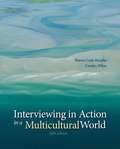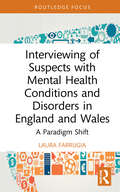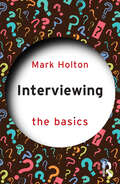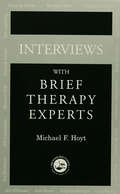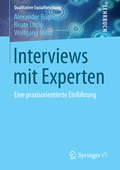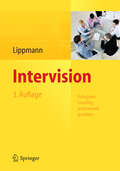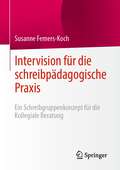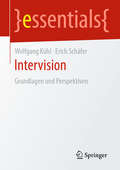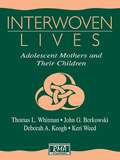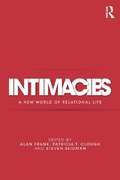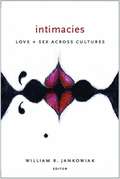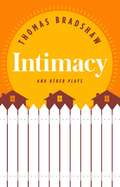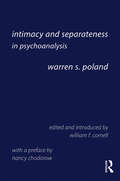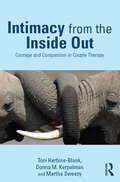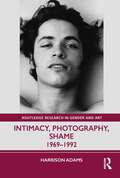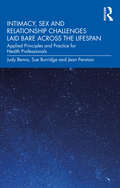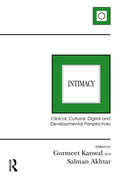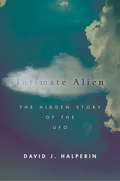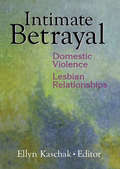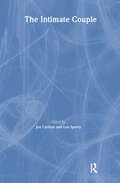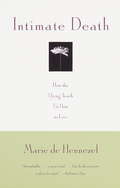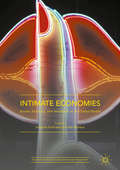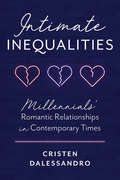- Table View
- List View
Interviewing in Action in a Multicultural World, Fifth Edition
by Bianca Cody Murphy Carolyn DillonThis is a text for both graduate and undergraduate students preparing to work in a variety of fields: social work, counseling, psychology, human services, criminal justice, psychiatric nursing, school counselors, and a variety of other helping professions. The book provides students with the clinical wisdom and hands-on practice to fully develop their clinical interviewing skills.
Interviewing of Suspects with Mental Health Conditions and Disorders in England and Wales: A Paradigm Shift (Routledge Frontiers of Criminal Justice)
by Laura FarrugiaInterviewing of Suspects with Mental Health Conditions and Disorders in England and Wales explores cutting-edge research that focuses specifically on these adults (including their cognitive needs and psychological vulnerabilities), the impact on the investigative interview, and existing legislation, guidance and practice. The book opens with a historical overview of the move from interrogation to investigative interviewing, including the impact of well-known miscarriages of justice and the inquiry that led to the development of current best practice interviewing. Further chapters focus on the concept of vulnerability within current theoretical frameworks, with a particular emphasis on mental health conditions and disorders, including how they are constructed, understood, and identified within legislation and by those working at the forefront of the criminal justice system. The book also examines current safeguards available to the suspect with mental health conditions and disorders, such as the Appropriate Adult; contemporary research explores their involvement with vulnerable suspects and whether it is sufficient, as well as how the Appropriate Adult understands and experiences their role. Final chapters scrutinise current best practice investigative interviewing of suspects with mental health conditions and disorders, and a paradigm shift towards an emerging evidence-based interview model that considers the vulnerabilities associated with suspects with mental health conditions and disorders in the investigative interview. Examining current psychological theory, contemporary research and existing legislation and guidance including authorised professional practice, this book will be of interest to those working within the criminal justice system, as well as policing and forensic psychology students. In particular, it is essential reading for all serving and trainee police officers, those delivering investigative interviewing training, and interviewing personnel, such as Appropriate Adults.
Interviewing: Principles and Practices
by Charles J. Stewart William B. CashInterviewing: Principles and Practices, the most widely used text for the interviewing course, continues to reflect the growing sophistication with which interviewing is being approached, incorporating the ever-expanding body of research in all types of interview settings, recent communication theory, and the importance of equal opportunity laws on interviewing practices. <p><p> It provides the most thorough treatment of the basics of interviewing, including the complex interpersonal communication process, types and uses of questions, and the structuring of interviews from opening to closing. <p><p> The Connect course for this offering includes SmartBook, an adaptive reading and study experience which guides students to master, recall, and apply key concepts while providing automatically-graded assessments.
Interviewing: The Basics (The Basics)
by Mark HoltonThis text outlines the relative merits of qualitative interviewing to new and emerging scholars in an accessible way. This is achieved not by providing an exhaustive ‘how-to’ guide but in introducing researchers to the interview technique and using examples of ‘best practice’ from across the social sciences.To ensure the book is both accessible and inclusive, efforts have been made to include case studies from a diverse range of authors, including those from different ethnic and social backgrounds, from outside Western Europe/North America, and from non-academic sources. This book will therefore introduce the reader to the key themes surrounding interview design, implementation, analysis and presentation, using examples and case studies from research across the social sciences. Crucially, the book will not provide exhaustive guidance on how to conduct the techniques. Instead, each chapter includes a range of interview design activities for readers to try which might help them engage with the chapter topics, as well as a 'Summary' box which comprises a short annotated reading list of key texts relating to each of the chapter topics and a checklist of things to consider relating to the chapter topics.
Interviews With Brief Therapy Experts
by Michael F. HoytFirst published in 2001. Routledge is an imprint of Taylor & Francis, an informa company.
Interviews mit Experten: Eine praxisorientierte Einführung (Qualitative Sozialforschung)
by Wolfgang Menz Alexander Bogner Beate LittigDie eminente Bedeutung von ExpertInneninterviews für die Forschungspraxis ist unumstritten. Sie gehören in vielen sozialwissenschaftlichen Disziplinen zur alltäglichen Forschungspraxis; sei es als eigenständige Erhebungsmethode, sei es als exploratives oder ergänzendes Instrument im Kontext quantitativer oder qualitativer Forschungsdesigns. Auf der anderen Seite sind ExpertInneninterviews trotz (oder wegen?) ihrer Praxisrelevanz methodisch wenig reflektiert. Dieses Defizit will der vorliegende Band beheben und eine übersichtliche, fundierte und an forschungspraktischen Problemen orientierte Einführung in Theorie und Praxis der ExpertInneninterviews bieten. Neben der Diskussion des methodologischen Hintergrunds und zentraler wissenssoziologischer Basisannahmen (ExpertInnenbegriff, Wissensformen) steht dabei insbesondere die Vorbereitung, Durchführung und Auswertung von ExpertInneninterviews im Mittelpunkt.
Intervision
by Eric D. LippmannIntervision ist eine spezielle Form des Gruppencoachings, bei der sich Gruppen ohne externe Fachperson treffen, um ihre berufliche Arbeit zu reflektieren - ein Setting, das sich seit Jahren bewährt. Der Autor, Psychologe und erfahrener Organisationsberater, liefert die Grundlagen für den Einstieg in die Praxis der Intervision. Er beschreibt ein einfach nachvollziehbares 6-stufiges Grundmodell und die dazugehörigen Methoden. Schritt-für-Schritt-Anleitungen begleiten die professionelle Einführung und Gestaltung der Intervision in Unternehmen.
Intervision für die schreibpädagogische Praxis: Ein Schreibgruppenkonzept für die Kollegiale Beratung
by Susanne Femers-KochIntervision gilt als Form selbstorganisierten Lernens in einem Setting Kollegialer Beratung, die für das Ziel der Professionalisierung das berufliche Handeln in Selbst- und Fremdreflexion in den Blick nimmt. In vielen (sozial-)pädagogischen und psychotherapeutischen Kontexten hat sich diese Form der Kollegialen Beratung als Selbstverständlichkeit und institutionalisierte Form der beruflichen Qualifizierung etabliert. Anliegen des vorliegenden Buches war es, Relevanz und Gestaltung von Intervision für die schreibpädagogische Praxis zu explorieren.
Intervision: Grundlagen und Perspektiven (essentials)
by Erich Schäfer Wolfgang KühlWolfgang Kühl und Erich Schäfer vermitteln in diesem essential Kenntnisse über die wissenschaftlichen und methodischen Grundlagen der Intervision. Sie geben Hinweise für die Implementation eines Reflexionssystems, in dem der Intervision eine zentrale Funktion zukommt, und geben Anregungen für die Gestaltung der Passung von individuums-, team- und organisationsbezogenen Reflexions- und Transformationsprozessen, insbesondere vor dem Hintergrund der New Work.
Interwoven Lives: Adolescent Mothers and Their Children (Research Monographs in Adolescence Series)
by Thomas L. Whitman Keri Weed John G. Borkowski Deborah A. KeoghDespite a growing body of scholarship on the phenomenon of adolescent parenting, minimal attention has been given to investigating systematic changes in adolescent mothers' and their children's psychological functioning over time. This book reports on a longitudinal study conducted to examine the social and psychological consequences of teen parenting for both mothers and their children. Qualitative and quantitative analyses are used to explain why some mothers and children fare better than others, showing that the lives and developmental trajectories of adolescent mothers and children are inextricably interwoven and closely linked to the social contexts within which they live. The book closes with social policy implications of the research including recommendations for intervention programs and policies to help adolescent parents and their children achieve developmental success and find happiness.
Intimacies: A New World of Relational Life
by Patricia Ticineto Clough Steven Seidman Alan FrankIn the last decade or so, there has been a shift in the popular and academic discussion of our personal lives. Relationships – and not necessarily marriage – have gravitated to the center of our relational lives. Many of us feel entitled to seek intimacy, an emotionally depthful social bonding, rather than simply security or companionship from our relationships. Unlike in a marriage-centred culture, intimacy is today pursued in varied relationships, from familial to friends and to romances. And intimacies are being forged in multiple venues, from face-to-face to virtual, cyber contexts. A new scholarship has addressed this changing terrain of personal life – there is today a vast literature on cohabitation, parenthood without marriage, sex and love outside marriage, queer families, cyber intimacies and friendships. However, much theorizing and research has focussed either on the interior, subjective or sociocultural aspects of intimacies, not their interaction. This volume aims to break new ground: Intimacies explores the psychological terrain of intimacy in depthful ways without abandoning its sociohistorical context and the centrality of power dynamics. Drawing on a rich archive that includes the social sciences, feminism, queer studies, and psychoanalysis, the contributors examine: changing cultures of intimacy fluid and solid attachments and intimacies from hook ups, to sibling bonds, to erotic love a politics of intimacy that may involve state enforced hierarchies, class, misrecognition, social exclusion and violence embodied experiences of intimacy and dynamics of endings and loss a pluralization of intimacies that challenge established ethical hierarchies This volume aims to define the cutting edge of this emerging field of scholarship and politics. It challenges existing paradigms that assume rigid hierarchical approaches to relational life. Intimacies will be of interest for psychoanalysts and for students or scholars in sexualities, gender studies, family studies, feminism studies, queer studies, social class, cultural studies, and philosophy.
Intimacies: Love and Sex Across Cultures
by William R. JankowiakA groundbreaking study of the ways in which we separate the search for sexual fulfillment from the impulse of love.
Intimacy and Alienation: Memory, Trauma and Personal Being
by Russell MearesIntimacy and Alienation puts forward the author's unique paradigm for psychotherapy and counselling based on the assumption that each patient has suffered a disruption of the `self', and that the goal of the therapist is to identify and work with that disruption. Using many clinical illustrations, and drawing on self psychology, attachment therapy and theories of trauma, Russell Meares looks at the nature of self and how it develops, before going on to explore the form and feeling of experience when self is disrupted in a traumatic way, and focusing on ways towards the restoration of the self. Written in an accessible style from the author's singular perspective, Intimacy and Alienation will appeal to professionals in the fields of psychotherapy, counselling, social work and psychiatry, as well as to students and the lay reader.
Intimacy and Other Plays
by Thomas Bradshaw"Bradshaw has proved in play after play that he has a confident vision of the theater that is his own. The politically incorrect plots jump merrily from one outrage to another, never pausing to explain motivation or linger on subtext. His dramas ask: What would happen if every dark urge, lingering resentment and unedited ugly insult that popped into your head came spilling out of your mouth? . . . No playwright applies as ruthlessly Hitchcock's definition of drama as 'life with the boring parts taken out.'"-The New York TimesInterracial couple Jerry and Pat borrow tools from their recently widowed, white evangelical neighbor James, and they even share the same Latino contractor, the mysterious Fred. Everything's suburban bliss until James, after discovering his neighbors' daughter Janet is a budding porn star, shuns the family. But what James doesn't know is that his aspiring-filmmaker son Matthew has other ideas...An outrageous and revealing comedy about race, sex, and familiarity, Intimacy, the newest work by playwright Thomas Bradshaw, premiered Off-Broadway with The New Group in winter 2014. This collection from the fiercely provocative and funny playwright also includes Dawn, Fulfillment, Southern Promises, Job, Strom Thurmond Is Not a Racist, Lecture on the Blues and Purity.Thomas Bradshaw's other plays include The Bereaved, declared a New York Times Critic's Pick and one of the Best Plays of 2009 by Time Out New York; Mary; and Burning. He was hailed as the Best Provocative Playwright of 2007 by the Village Voice.
Intimacy and Separateness in Psychoanalysis
by Warren S. PolandClinical psychoanalysis serves as our best laboratory for exploring the riddle of what it is to be a person, and how a person is at once singularly unique while always a piece of the interpersonal fabric of humanity. In Intimacy and Separateness in Psychoanalysis, Warren Poland casts a freshly erudite eye on this paradox, resisting individual or intersubjective bias and avoiding the parochial allegiances common in our age of pluralism. Poland combines vivid reports from clinical analyses, literary readings, and his own life – all unfolding original observations on a person as both a part of and apart from human commonality. His consideration of how one person’s witnessing facilitates another’s self-definition, a concept extended here in his study of outsiderness as part of human nature, has been marked a keynote contribution. Clinical illustrations of moments that matter but are usually omitted from public presentation are set alongside examples of reading powerful fiction to show how analyst and author both incite fresh openness in a person’s mind. Poland goes farther, exposing the personal power of union and separateness in its keenest form, facing the ultimate separation of one’s own actual death. Only with separateness can true intimacy grow, and only within the fabric of others can true individuality exist. This evocative book, ranging from the lightness of whimsy to the dread of dying, allows every reader to taste of and learn from Poland’s thinking. Psychoanalyst or patient, writer or reader, each one living one’s own life – all can find new understandings in this work.
Intimacy from the Inside Out: Courage and Compassion in Couple Therapy
by Toni Herbine-Blank Donna M. Kerpelman Martha SweezyCouples in distress enter therapy holding two goals that they now experience as mutually exclusive: to feel loved and to feel understood. Toni Herbine-Blank’s powerful new brand of couple therapy, Intimacy from the Inside Out (IFIO), offers a comprehensive conceptual map for achieving both goals. In a tour de force of elegant case illustrations wrapped around clear instruction, this book shows the IFIO therapist working with the natural subdivisions – or parts – of the human mind in a dyad, guiding and supporting couples to understand how they project childhood injury into current relationships and then, feeling threatened, frustrated and angry, lose track of their underlying needs to feel safe, connected and loved. With a focus on generating internal attachment stability to sustain each partner through the moments when the other is unavailable, couples in IFIO therapy reconnect with their essential needs, change their conversations and learn to make requests that invite rather than threaten in order to get those needs met.
Intimacy, Photography, Shame: 1969–1992 (Routledge Research in Gender and Art)
by Harrison AdamsThis study argues that intimacy requires an overcoming of shame, and each of these artists, in their own way, uses photography to frame moments that can be shameful to some and intimate others, leaving it to the viewer to navigate this affectively perilous terrain.From the cancellation of Mapplethorpe’s retrospective The Perfect Moment to the obscenity trial in Cincinnati shortly thereafter, to Hujar’s lesser-known but equally “hardcore” imagery, to Goldin’s gritty depictions of domestic violence and substance abuse, to the accusations of child pornography thrown at Mann’s photographs of her own children, the photographers at the heart of this book have probed the limits of acceptability. But there is more to their work than merely controversy; it’s what causes the controversy that matters. The notion of intimacy is at stake in some of our most important human relationships, and thus a great deal hinges on both achieving and preserving intimacy.This book will be of interest to scholars working in art history, photography and gender studies.
Intimacy, Sex and Relationship Challenges Laid Bare Across the Lifespan: Applied Principles and Practice for Health Professionals
by Judy Benns Sue Burridge Jean PenmanThis accessible book uses case studies to explore issues around intimacy, sexual function and sexual development over the lifespan, introducing applied principles and practices when working with sexuality-related issues. Introducing an easy-to-use ‘Reflect and Respond’ model as a framework for interactions, this book discusses a broad selection of topics and life stages, including hidden loss, gender identity, disability, early years experiences and older age. Exposing anonymized real-life experiences of intimacy, sexual function, and sexual development from birth to end of life, this book develops the reader’s insight into sexual wellbeing and confidence in communicating about it. The experiential learning and research-based content in readable style will educate and inspire readers with an interest in sexual wellbeing and how this impacts on physical and mental health. Demonstrating how being open to talk about sex and intimacy can change lives, this guide is suitable for a wide range of health and social care professionals, including nurses, doctors, occupational therapists, social workers, psychologists and counsellors.
Intimacy: Clinical, Cultural, Digital and Developmental Perspectives (Margaret S. Mahler Ser.)
by Salman Akhtar Gurmeet KanwalIntimacy: Clinical, Cultural, Digital and Developmental Perspectives applies a contemporary, psychoanalytic lens to the many facets of intimacy between people, from romantic and sexual relationships, to friendliness, as well as the ways intimacy is mediated by new digital technologies. Identifying commonalities and differences between a range of approaches, including Classical Freudian, attachment theory, and interpersonal theory, the book includes case studies that highlight how intimacy is framed in a variety of relationships. It examines the line between privacy and intimacy, as well as how intimacy changes at different stages of one’s lifespan. From the friends we have to the pets we own, or the faith we follow, a cross-cultural perspective ensures that intimacy is conceived of as a broad, essential element underlying all human relationships. The intimacy between analyst and analysand is also examined. This far-reaching book will interest both practicing and training psychoanalysts and psychotherapists, as well as those in related disciplines.
Intimate Alien: The Hidden Story of the UFO (Spiritual Phenomena)
by David J. HalperinA voyage of exploration to the outer reaches of our inner lives. UFOs are a myth, says David J. Halperin—but myths are real. The power and fascination of the UFO has nothing to do with space travel or life on other planets. It's about us, our longings and terrors, and especially the greatest terror of all: the end of our existence. This is a book about UFOs that goes beyond believing in them or debunking them and to a fresh understanding of what they tell us about ourselves as individuals, as a culture, and as a species. In the 1960s, Halperin was a teenage UFOlogist, convinced that flying saucers were real and that it was his life's mission to solve their mystery. He would become a professor of religious studies, with traditions of heavenly journeys his specialty. With Intimate Alien, he looks back to explore what UFOs once meant to him as a boy growing up in a home haunted by death and what they still mean for millions, believers and deniers alike. From the prehistoric Balkans to the deserts of New Mexico, from the biblical visions of Ezekiel to modern abduction encounters, Intimate Alien traces the hidden story of the UFO. It's a human story from beginning to end, no less mysterious and fantastic for its earthliness. A collective cultural dream, UFOs transport us to the outer limits of that most alien yet intimate frontier, our own inner space.
Intimate Betrayal: Domestic Violence in Lesbian Relationships
by Ellyn KaschakHelp ease the secret suffering of lesbians in abusive relationships!Why is woman-on-woman violence so often ignored or discounted? Intimate Betrayal: Domestic Violence in Lesbian Relationships uncovers the hidden problem of lesbians who hurt the women they love. This long-needed book brings together theory, practice, and research to suggest new and fruitful ways to understand, prevent, and treat this common problem. Intimate Betrayal provides new empirical research into the psychological and sociocultural causes of abuse. As several of the chapter authors demonstrate, neither traditional feminist theories about power nor heterosexist paradigms explain the causes, dynamics, or treatment of this problem. However, the new research presented here suggests helpful diagnostic criteria and effective treatments. Intimate Betrayal analyzes the factors that contribute to lesbian domestic violence, including: heterosexism and homophobia minority stress emotional isolation and lack of community ties revictimization of women who have previously suffered abuseThe thorough literature review included reveals the paucity of attention that has been paid to this problem. Intimate Betrayal suggests exciting new models for freeing women from domestic violence, including the use of clinical and community resources and liberation theology. Community activists, counselors, and psychologists will be intrigued by the insightful analysis of the root causes of lesbian-on-lesbian violence and the valuable treatment suggestions. Researchers will welcome the new avenues it opens for additional research.
Intimate Couple
by Jon Carlson Len SperryAs important as intimacy is in our personal and professional lives, intimacy as a theoretical and clinical factor still remains a phenomenon. Contributors to this work examine the many definitions of intimacy, putting forth a provocative discussion of the multi-faceted topic and offering the best possible clinical methods of creating intimacy and addressing its challenges.
Intimate Death
by Marie De HennezelHow do we learn to die? Most of us spend our lives avoiding that question, but this luminous book--a major best-seller in France--answers it with a directness and eloquence that are nothing less than transforming. As a psychologist in a hospital for the terminally ill in Paris, Marie de Hennezel has spent seven years tending to people who are relinquishing their hold on life. She tells the stories of her patients and their families. de Hennezel teaches us how to turn death--our loved ones' or our own--from something lonely and agonizing into a sacred passage. She discusses the importance of an honest reckoning, the value of ritual, the necessity of touch. In imparting these lessons,Intimate Deathbecomes a guide to living more fully, more intensely, than we had thought possible. "Unique. . . Of all the books I have read about the endings of our lives, this elegiac testimony has taught me the most. "--Sherwin B. Nuland, M. D. , author ofHow We Die "The quiet, obvious truths [de Hennezel] discovers in her work--these things have a kind of cumulative power. "--Washington Post Book World
Intimate Economies
by Susanne Hofmann Adi MorenoThis book illustrates how intimate workers in different socio-cultural contexts negotiate the commercial uses of their sexuality, identity, affect, and bodies, thereby often defying inequality, impoverishment, and resource depletion in their regions. The studies shed light on the multi-faceted experiences of subjects involved in intimate economies, oscillating between personal empowerment and agency, as well as the required subjection to the demands of the current market regime, entailing participation in precarious employment, often involving bodily risk, economic exploitation and stigmatization. The contributions demonstrate the interrelatedness of market intimacy, family economies, and transnational care arrangements, and thereby challenge Western notions of the subject and the free market.
Intimate Inequalities: Millennials' Romantic Relationships in Contemporary Times
by Cristen DalessandroWhen it comes to the topic of romantic and sexual intimacy, social observers are often quick to throw criticisms at millennials. However, we know little about millennials’ own hopes, fears, struggles, and triumphs in their relationships from the perspectives of millennials themselves. Intimate Inequalities uses millennials’ own stories to explore how they navigate gender, race, social class, sexuality, and age identities and expectations in their relationships. Situating millennials’ lives within contemporary social and cultural conditions in the United States, Intimate Inequalities takes an intersectional approach to examining how millennials challenge—or rather, uphold—social inequalities in their lives as they come into their own as full adults. Intimate Inequalities provides an in-depth look into the intimate lives of one group of millennials living in the United States, demystifying what actually goes on behind closed doors, and arguing that millennials’ private lives can reveal much about their ability to navigate inequalities in their lives more broadly.
